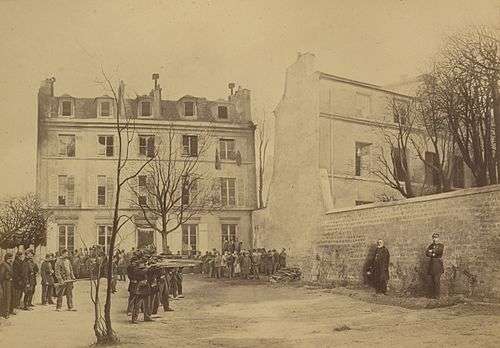Jacques Leon Clément-Thomas
| Jacques Léon Clément-Thomas | |
|---|---|
.jpg) | |
| Born |
December 31, 1809 |
| Died |
March 18, 1871 |
| Rank | General[1] |
Jacques Léon Clément-Thomas, was born in 1809[2] in Libourne (Gironde) and shot on 18 March 1871 in Paris. Clément-Thomas was an army General, Commander in Chief of the National Guard on two occasions, and a parliamentary deputy. A Republican of the old guard, Clément-Thomas was one of the first deaths of the Paris Commune.[1]
Early Military and Political Career
Jacques Léon Clément-Thomas joined the army as a volunteer at the age of twenty.[1] As a junior officer of republican tendencies, he was implicated in several plots (including that of Lunéville) during the July Monarchy. Arrested in 1835, he managed to escape from the Sainte-Pelagie prison in Paris.[3]
Exiled to England, Clément-Thomas returned to France after the amnesty of political offenders in 1837 and collaborated with the newspaper Le National, the organ of the "bourgeois Republican" majority. Clément-Thomas was a supporter of the French Second Republic[3] and was elected to the Constituent Assembly in 1848 as member for Gironde. When the uprising of June 1848 broke out, he was placed in command of the National Guard of the Seine, which harshly repressed the revolting workers of the National Ateliers. Clément-Thomas failed to be elected a deputy of the Legislative Assembly in 1849.
Clément-Thomas opposed Napoleon III's coup d'état of December 2, 1851 and vainly tried to raise the Gironde against the coup. During the Second French Empire, he went into exile in Belgium and Luxembourg.[4][5]
Return to the National Guard
Clément-Thomas returned to Paris after the proclamation of the Republic[4]:282 on 4 September 1870. The Government of National Defence appointed him commander in chief of the National Guard of the Seine during the siege of Paris.[4]:282 He participated in the disastrous Buzenval breakout attempt of 20 January 1871. Clément-Thomas resigned his command on 13 February.
Execution
During the uprising of 18 March 1871, in civilian clothes, Clément-Thomas reconnoitered the barricades of Montmartre.[6] Recognized, he was seized by the crowd, thrown on the corpse of General Claude Lecomte, who had been lynched a few minutes earlier, and massacred in turn. Their bodies remained exposed for two days on rue des Rosiers (now rue du Chevalier-de-la-Barre).

A Doctor Guyon, who examined the bodies afterwards, found forty balls in the body of Clément-Thomas and nine balls in the back of Lecomte.[7][8]
The legend that Generals Lecomte and Thomas were shot "in a regulation manner" by a firing squad was a fabrication:[9] it is based on a photograph staged by the photographer Eugène Appert, which was taken in June, three months later.[10] There was even an activist theater production (La Commune, historical drama, 1908), which portrays a pseudo-trial of the two generals before their execution.
See also
Sources
- "Jacques Léon Clément-Thomas," in Robert and Cougny, dans Robert et Cougny, Dictionnaire des parlementaires français, (Dictionary of French parliamentarians) 1889
- Bernard Noël, Dictionnaire de la Commune, Flammarion, collection Champs, 1978.
- Récit de l'exécution des Généraux Lecomte et Clément-Thomas par Alphonse Daudet dans Le jardin de la rue des rosiers - Souvenirs d'un homme de lettres
References
- 1 2 3 L'Illustration européenne, first year, issue 21, Bruxelles, 8 April 1871, p. 168
- ↑ Jouin, Henri Auguste (1898). La sculpture dans les cimetières de Paris. Mâcon: Protat frères. p. 53.
- 1 2 Robert, Adolphe; Cougny, Gaston. Bourloton, Edgar, ed. Dictionnaire des parlementaires français... : depuis le 1er mai 1789 jusqu'au 1er mai 1889.... Gallica. 5. p. 413.
- 1 2 3 Publications de la Société pour la recherche et la conservation des monuments historiques dans le Grand-Duché de Luxembourg. 29-30. Luxembourg: Société pour la recherche et la conservation des monuments historiques dans le Grand-Duché de Luxembourg. 1875. p. 281.
Exilé de la France, il vint dans la Grand-Duché...
- ↑ "Sektkellerei Schloss Moestroff". Industriegeschicht vu Lëtzebuerg.
Clément-Thomas loue/achète? le château de Bollendorf de 1867-1870. Il retourne à Paris en 9 1870 après la proclamation de la République.
- ↑ Trochu, Louis-Jules. Œuvre posthume. 1. Tours: A. Mame et fils. p. 53.
- ↑ Milza, Pierre (2009). L'année terrible: La Commune (mars–juin 1871). Paris: Perrin. p. 19. ISBN 978-2-262-03073-5.
- ↑ Gluckstein, Donny (15 January 2014). Paris Commune: A Revolution in Democracy. Haymarket Books. p. 231.
- ↑ "Archive: Photographs of the Paris Commune". Musée d'Orsay. 5 December 2008.
the first political photomontages appeared, with evocative titles - Crimes of the Commune (Eugène Appert), Martyrs of La Roquette (Hippolyte Vauvray) - faked pictures, with an anti-communard purpose, reconstructions after the event of episodes from the Commune with the help of actors in costume, highlighting mostly the executions of hostages by insurgents in May 1871.
- ↑ Tillier, Bertrand (2004). La Commune de Paris, révolution sans images?: politique et représentations dans la France républicaine (1871-1914). Ceyzérieu: Editions Champ Vallon. p. 68. ISBN 9782876733909.
c'est au début du mois du juin 1871 que Eugène Appert entreprit sa serie de photomontages des Crimes de la Commune